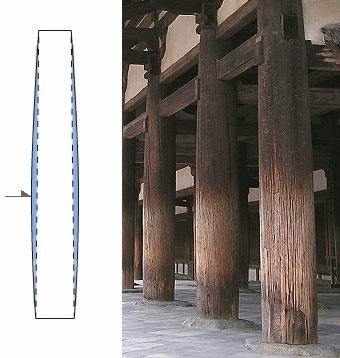| Entasis.
The bulge in the center of a circular pillar to make it appear straight.
In Japan circular pillars called *marubashira
丸柱 had base stones *soseki
礎石 and were placed on a podium *kidan
基壇. They had a bracket system *tokyou
斗きょう on top and were in common use by the 7c-8c. Entasis originated with
the ancient Greeks and was a clever device to make their stone columns appear
straight. If made straight, they would have appeared to have an inward curve.
This method of building was introduced to the Asian continent by the end
of the 6c. The use of entasis undoubtedly reached China via the Silk Route
through Central Asia, probably during the 3c-4c. The Japanese learned the
technique during the late 6c - early 7c when continental building methods
were introduced from Korea and China. Some of the original buildings remaining
from that early period show entasis in the pillars, for example, Houryuuji *Kondou 法隆寺金堂 in Nara The Kondou was rebuilt in 693. The variations
in diameter are easily discernible. |

